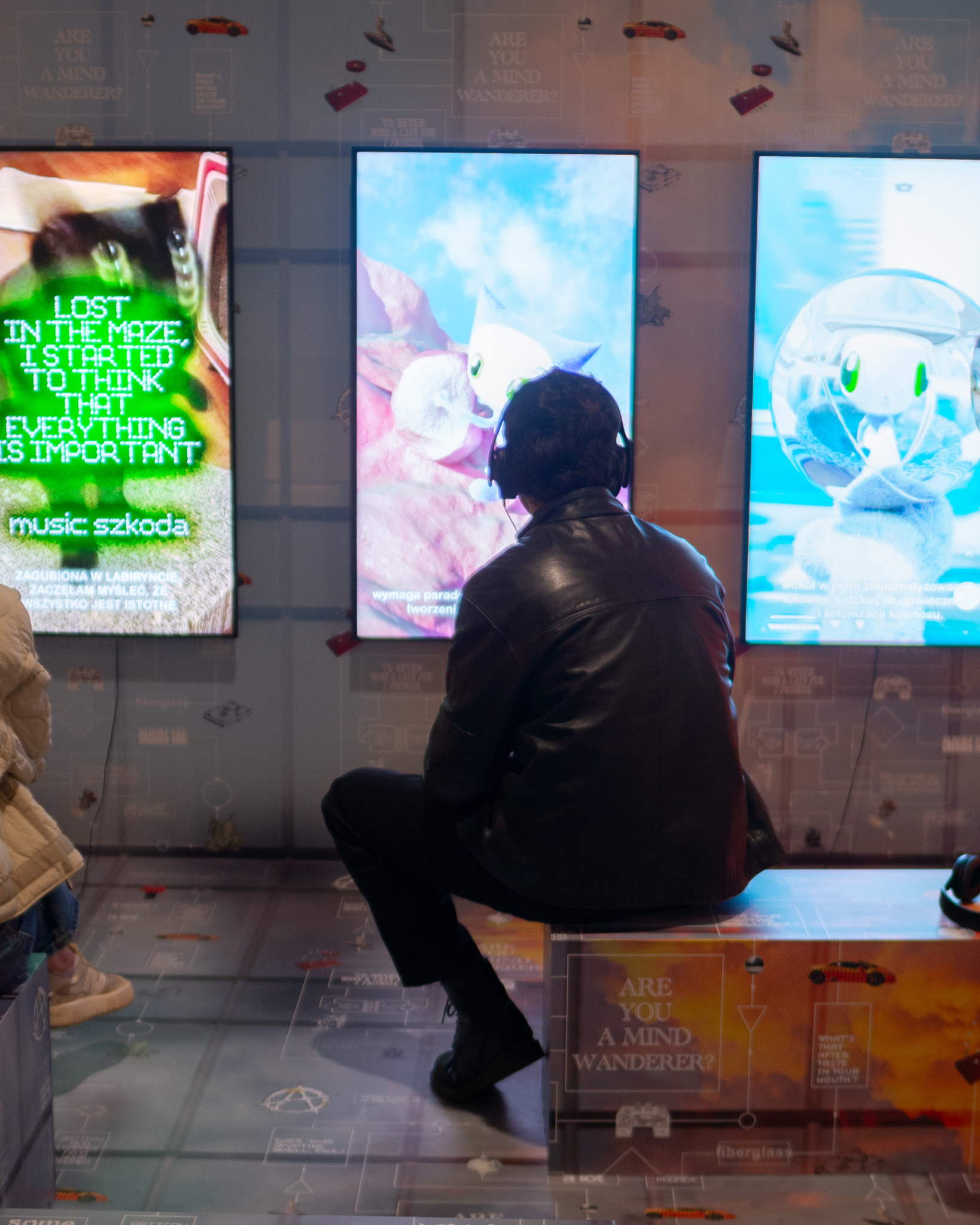No. 39
Internet is All about Hormones. Between the Practices of Extreme Online Presence and Molecular “Lore”
29.04.2024
Kat Zavada
Instagram guides caution you to choose your dopamine wisely. Content about hormones and neurotransmitters, or the molecules that control the human body, has become part of Internet culture. In an experiment on my own body, I explored the political aspects of molecular lore[1] while trying to use it as a methodological framework for perceiving and analysing art. How is my neurobiological economy affected by the works of the duo Xtreme Girl, Agata Lankamer, Justyna Górowska, Karolina Jarzębak and Sara Bezovšek, which refer to the aesthetics of extreme online presence, as shown in the exhibition From the Ashes, and what would a hormone coach have to say about them?
My body is a machine[2]
Our bodies are machines powered by hormones and neurotransmitters – my Instagram feed makes me believe – and I fall in love with this technocratic narrative, my face flushed with excitement. The joy of a serotonin surge, dopamine rush, embracing oxytocin, ominous cortisol. Human affect is measurable and, moreover, manageable. And since chemical molecules drive emotions and actions, they seem to be the building blocks of our subjectivity. A subjectivity that is plastic, can be freely defragmented and reassembled, added to and subtracted from through various self-care practices – running boosts dopamine levels, cuddling raises oxytocin, and so on. My body is a sexy machine shimmering in the spring sun, and the ‘sun is, after all, also hormones’.[3] Intellectual excitement made me try molecular biohacking[4] and create my own protocols[5] in the language of molecular narratives. I was most interested in contrasting combinations – e.g. jogging to Lana Del Rey’s Cruel World[6] or watching pornography while sipping a smoothie. The next step was measurement. It turned out that testing the levels of the neurotransmitters I was most curious about – serotonin, oxytocin, dopamine or endorphins – was beyond my financial reach[7]. Even if I had tested them, the technology available to me would only have allowed me to record that particular moment, to capture the ephemeral variable on the fly. Molecular narrative revealed its problematic character for the first time – the machine felt sad. And although mapping my inner molecular landscape remained in the realm of fantasy, the attempt to use it as a method of reading art marked the beginning of my physical and intellectual experiment. The beginning of an auto theory of molecular narratives in Internet culture and, above all, of their biopolitical[8] dimension.
[1] Lore is ‘background information about the fictional in a book, film, computer game, etc. and the fictional place and situation in which its events happen …’. Lore essentially consists of outlines of topography, history and genealogy, as well as cause-and-effect relationships co-created by the players. (https://dictionary.cambridge.org/dictionary/english/lore). The term refers to the narratives and rules that govern the world of games, and has been adopted by internet culture and social media in recent years.
See https://www.businessinsider.com/rizz-girl-dinner-lore-canon-barbie-grimace-millennial-tiktok-slang-2023-7?IR=T#rizz-1 (accessed 16 April 2024).
[2] Reference to the meme My body is a machine, https://knowyourmeme.com/memes/my-body-is-a-machine-that-turns-x-into-y (accessed 16 April 2024).
[3] Reference to a fragment of a poem by Filip Matwiejczuk [bad moon], https://www.instagram.com/p/B6sVwAynRlN/?igsh=dmIyMnIyY2E5OXU5 (accessed 16 April 2024).
[4]Biohacking is ‘the practice of employing methods drawn from fields like biology, genetics, neuroscience and nutrition to enhance physical or mental performance, improve overall health and well-being, or achieve a specific health outcome’; see https://www.forbes.com/health/wellness/biohacking/ (accessed 16 April 2024).
[5] My inspiration in this process is Joshua Citarella, an artist and researcher known for testing biohacks (e.g. nutritional supplements) on himself. Also known for a practice based on experimenting on his own body and creating autofiction based on it is Paul B. Preciado, whose views I refer to later in the text.
[6] I have no idea what neurobiology would say, but I’m fantasizing about how Lana Del Rey’s music affects the serotoninergic system, activating a previously unknown neurotransmitter, the chemical essence of melancholy, the romanticisation of sadness and American culture, commonly called the Sad Girl molecule.
[7] The cost of a dopamine test ranges from 150 to 300 PLN, while the combined test for serotonin, dopamine, noradrenaline and epinephrine costs about 460 PLN. A full panel costs about PLN 1200.
[8] I use the term ‘biopolitics’, after Michel Foucault, to describe the way in which power is produced, circulated and implemented something that rules individuals through a set of disciplines that normalise their bodies and their sense of pleasure. See https://www.cambridge.org/core/books/abs/cambridge-foucault-lexicon/biopolitics/2EE5418CEE87ADE3A8AFCCFC7AB46C20#access-block and https://books.google.pl/books?id=cRVNFqFPGtoC&pg=PA9&redir_esc=y#v=onepage&q&f=false (accessed 16 April 2024).
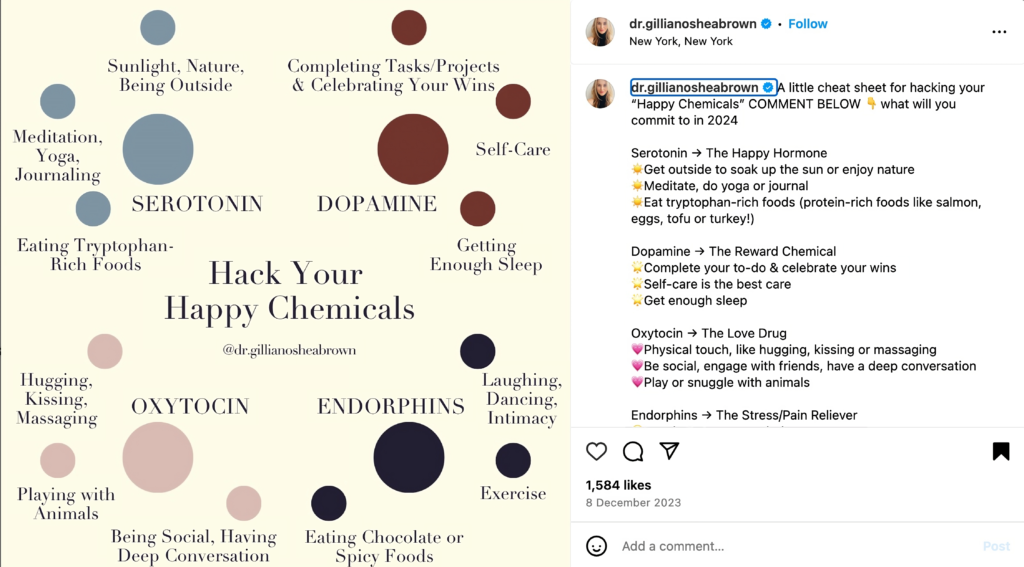
Molecular narrative or molecular lore?
What do I call molecular narrative or molecular lore? It is a set of practices for narrating and understanding the human universe through hormones and neurotransmitters, collectively considered as chemical signalling molecules that, according to current knowledge, are responsible for the behaviour and attitudes of the organism, and thus for affects and actions. However, drawing on the neurobiological paradigm, this narrative has been simplified by internet pop culture – from figures such as life coach Jay Shetty[9] and motivational speaker Mel Robbins[10], to Instagram and YouTube influencers[11] and meme accounts. This reductionist mechanism transfers the molecular narrative from the realm of hard science to a humanistic narrative of ‘self’ and its attendant aesthetics.[12]
[9] See https://www.jayshetty.me/ (accessed 16 April 2024).
[10] See https://www.melrobbins.com/about-mel (accessed 16 April 2024).
[11] See profiles like https://www.instagram.com/dr.gillianosheabrown/, https://www.instagram.com/incomeyard/, https://www.instagram.com/jamesmoorewellness/, https://www.instagram.com/nastasia.katharina/, https://www.instagram.com/your.anxiety.bible/, and https://www.instagram.com/cos_m___o/ or the channel https://www.youtube.com/@leonjhendrix (accessed 16 April 2024).
[12] See https://www.researchgate.net/publication/318305870_Difference_Between_Hormines_and_Neurotransmitters (accessed 16.04.20204).
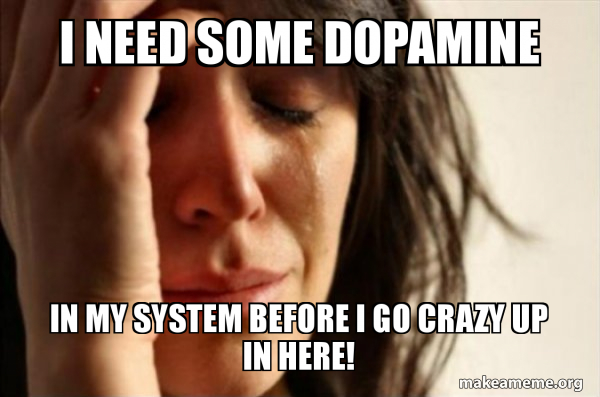
To follow Shumon Basar’s idea, we construct our ‘selves’ online through extreme auto-storytelling, or lorecore. According to the theoretician, everything on the Internet has become an aesthetic through which we understand and present ourselves, and this mechanism serves as a defence against contemporary crises. The term ‘lorecore’ refers to the aforementioned ‘lore’ and denotes practices of narrating oneself and one’s universe. Lorecore is part of being extremely online, being extremely yourself on the internet[13]. For me, this is molecular narrative – a way of looking at the subject and its relationality. Are all the memes and Instagram stories about longing for a dopamine surge preceded by an examination of its levels? Even if not, and it’s just a molecular fantasy about one’s ‘self’, its causality must be acknowledged both at the cultural, biopolitical level and in constructing subjectivity.
[13]See https://zine.zora.co/the-laws-of-lorecore-shumon-basar (accessed 16 April 2024).
Immersion in molecular lore
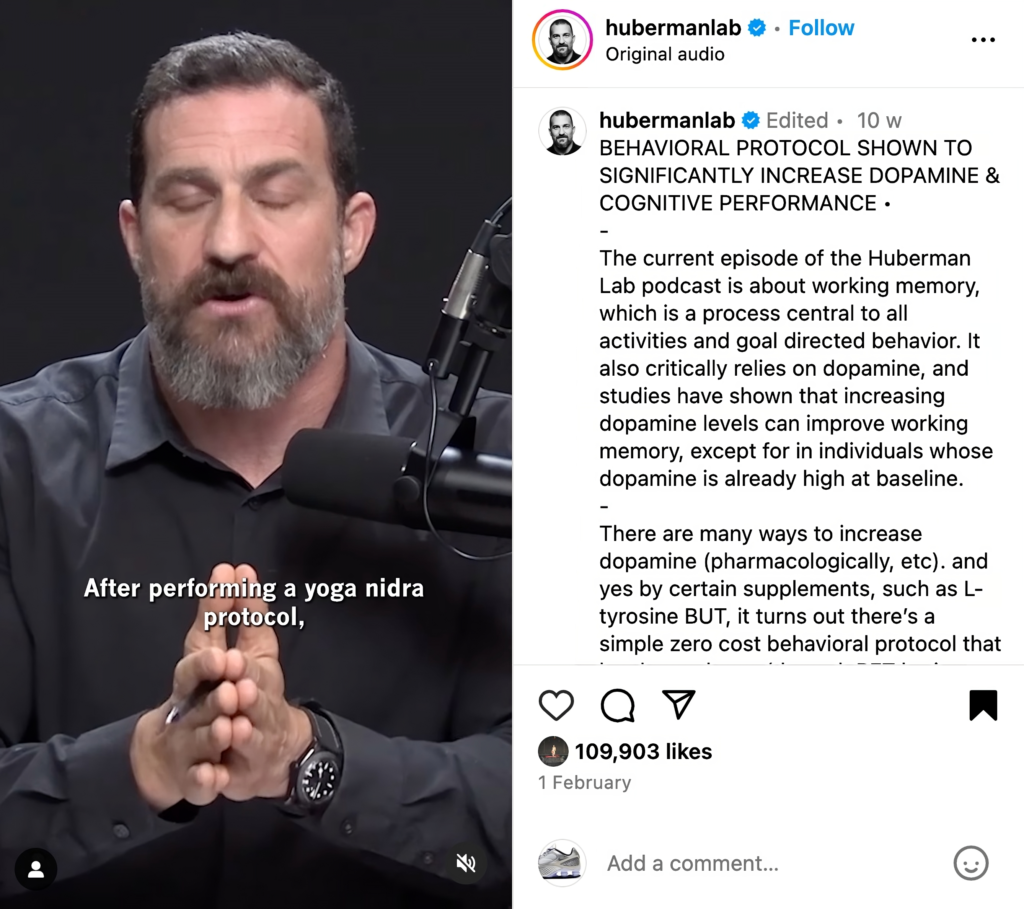
The molecular narrative has made its way into pop culture, thanks in part to Huberman Lab, the popular podcast of controversial[14] Stanford University neurobiologist Andrew Huberman. Huberman is famous for his ‘protocols’[15], or blueprints for optimising various aspects of our well-being (specific times to drink coffee, take cold baths, sunbathe at specific times). In his podcast we find information on managing our affect: how to improve productivity; how to control dopamine levels to increase motivation; how to manage serotonin levels, which depend on diet. This scientific approach to the subject, derived from neurochemistry and brain neurobiology, often fuses discursive forces with psychology[16]. Just as pop culture has distilled years of research into therapeutic theories into infographics about the narcissistic personality type and condensed knowledge about the mechanisms of trauma into thirty-second TikTok videos, neurobiology has not escaped a certain pop reduction. Scientists have long told us that the molecular landscape of the Internet is full of simplifications[17], but molecular influencers seem unconcerned with the complexities of hard science. The so-called happy hormones – serotonin, oxytocin, endorphins, dopamine – are actually neurotransmitters[18]. They are the topics that generate the most content on podcasts, social media and self-help groups on Reddit. Other popular molecules include cortisol, known as the stress hormone. On social media platforms, there are a growing number of hormone coaches who offer advice on how to manage your endocrine economy and create a personalised plan for you[19].
Molecular narrative is closely linked to being online – in the academic discourse, socioendocrinology already exists as a field dedicated to the influence of social media on hormone levels[20]. Molecular lore harbours the spirit of late capitalism, with its internally contradictory mechanisms. We can spend many hours scrolling through Instagram, only to learn that this is one of the worst possible dopamine pathways – the algorithm will ensure that we receive a constant stream of new, exciting content, which we will want to consume out of this charming compulsion, until we are saturated and ultimately exhausted.
[14]His approach has sparked controversy in the scientific community, where some have dubbed him a ‘pop neuroscientist’ or ‘wellness guru’. In his podcast, besides neurobiological knowledge, he also promotes expensive dietary supplements. Discussions around Huberman intensified after the publication of a viral article in New York Magazine in which women who had dated him accused him of, among other things, non-consensually seeing six people at the same time, thus undermining his credibility. See https://www.theguardian.com/us-news/2024/mar/28/podcaster-andrew-huberman-goop-for-bros (accessed 16 April 2024).
[15] His website has an AI tool that helps tailor protocols to our needs, see Huberman Lab AI, see https://ai.huberman lab.com (accessed 16 April 2024).
[16] In Poland, for example, this trend can be seen in the popular podcast ‘O zmierzchu’ by Marta Niedźwiedzka or ‘Podgórska ogólnie’, hosted by Polish neurobiologist Joanna Podgórska. English language examples include ‘The Science of Happiness’ by Professor Dacher Keltner and ‘Everyday Neuro: Psychology and Neuroscience Podcast’ hosted by Dr Janine Cooper.
[17] See https://www.theguardian.com/science/2013/feb/03/dopamine-the-unsexy-truth (accessed 16 April 2024).
[18] See https://www.researchgate.net/publication/318305870_Difference_Between_Hormines_and_Neurotransmitters (accessed 16 April 2024).
[19] See the accounts https://www.instagram.com/thehormonehealthcoach/?hl=en, https://www.instagram.com/sofreshnsogreeeeen/, https://www.instagram.com/leah_brueg/?hl=en, https://www.instagram.com/the_hormonal_health_coach/?hl=en, https://www.instagram.com/daveymahertransformations/?hl=en, https://www.instagram.com/danadinnawi/?hl=en, https://www.instagram.com/majamilicevic_/, https://www.instagram.com/anikanicole_/ (accessed 16.04.20204).
[20] See https://www.ncbi.nlm.nih.gov/pmc/articles/PMC10871011/ (accessed 17 April 2024).
Molecular aesthetics: protocols of happiness and productivity
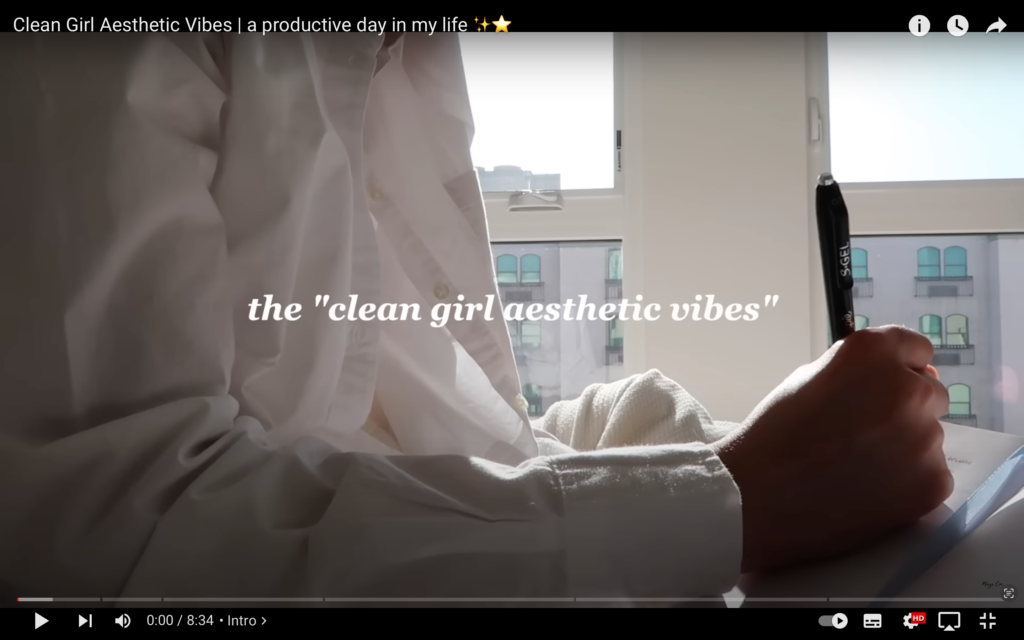
What exactly constitutes molecular aesthetics? They are protocols of happiness and recipes for the ‘good’ life, manifested in images of smiling runners, people starting their day with green smoothies, ‘clean girls’[21] waking up at 8am to be productive, ‘sigma men’ taking cold showers[22] to stimulate their dopamine pathways and walk the path of discipline and self-development. Bright, vibrant colours, minimalist fonts, beautiful images – molecularly optimised middle-class sleep. Touching human stories: ‘before’ – unproductive, sad, and lifeless; ‘after’ molecular enlightenment – healthy, energetic, smiling, and motivated. Pinterest brings us ‘dopamine home decor’[23], colourful interior design to inspire us to action every day. Likewise, Spotify is immersed in molecular lore – the algorithm knows which playlist to compile for me based on potential dopamine or serotonin deficiencies – the dopamine playlist starts with the song Deceptacon by Le Tigre[24].
[21] See https://www.youtube.com/watch?v=yfDQRspDgjo (accessed 17 April 2024).
[22] ‘Sigma male’ (or simply ‘sigma’) is a pseudo-scientific term from internet culture, most commonly used to describe a man who is a ‘lone wolf’, see https://www.dazeddigital.com/science-tech/article/55208/1/rise-and-grind-how-sigma-male-memes-are-upturning-the-man-o-sphere (accessed 17 April 2024).
[23] See https://pl.pinterest.com/search/pins/?rs=ac&len=2&q=dopamine%20home%20decor&eq=dopamine%20home&etslf=11921 (accessed 17 April 2024).
[24] See https://open.spotify.com/track/5773KSWFzg9kCc8yazjbSt?si=dae9c5fa389d4cc7 (accessed 17 April 2024).
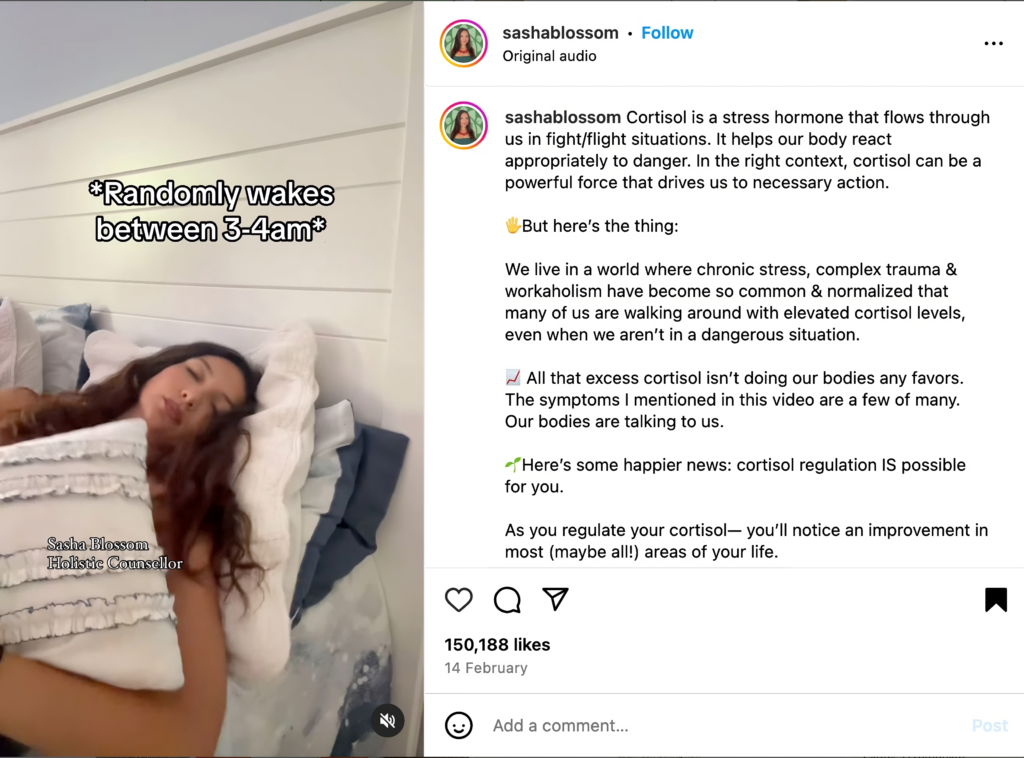
My Insta and TikTok feeds have been flooded with a chemical wave. Waking up at night? Cortisol levels are too high. No motivation? Dopamine levels are low. My Internet seems to be running amok, searching for ‘dopamine kicks’, participating in the so-called ‘dopamine rush’. The very phrase that compares today’s dopamine rush to the nineteenth century gold rush seems to be an accurate diagnosis of this internet trend. Once I synthesise knowledge from Instagram posts, I will be able to make a hazy self-diagnosis of my molecular ‘self’ – a machine powered by sexy neurotransmitters – but until I measure it, it remains a mere fantasy.
Problematic aspects of molecular lore
What is ‘natural’ always seems suspicious to me – natural inclinations stemming from biological sex differences, the natural need to work shaping its dogma. The biological argument is hard to dispute and cuts off the possibility of discussion, imposing a moral judgement or suspending it altogether[25]. What I find most interesting is the issue of molecular knowledge in the service of productivity. The aim of the online practices I mentioned earlier is to increase motivation. These molecular productivity protocols represent biopolitical social management. Although self-optimisation can be subject-building and have a liberating dimension for the individual, capital cunningly absorbs it and transforms it into a mechanism for its own accumulation. A happy subject is a productive one, and that is what is most desirable.
Soft and hard pharmacopornographies
Thinking about molecular practices, you cannot overlook Paul B. Preciado and his hormonal administration described in Testo Junkie[26]. How does a testo junkie differ from a clean girl? Molecules are a technological soma-tool[27] in the game of subjectivity, but the goal and the rules of the game can be quite different. The goal of a testo junkie is resistance, expressed in a radical experiment with one’s own body. This kind of hormonal practice is a political manifesto – it creates a subject that resists. They take soma-technology into their own hands, allow themselves to be dominated by the substance, and then in turn dominate it. It is a power play with identity and the socio-political order, in which the testo junkie intoxicates himself for psychic, intellectual and sexual pleasure. Preciado does not need a hormonal coach, because there is no equilibrium he strives for. The goal of the clean girl’s hormonal practices is optimisation – achieving the best version of oneself. This approach assumes that there is an optimal molecular level of human happiness and productivity. Here, the hormonal administration creates an optimal subject that conforms.
Soft version hacking: new protocols
Molecules are a technology that we can hack, adopt for our own subjectivity game, or use as an artistic methodology. We can consciously manage the affect of art recipients by creating soma-technologies and somato-theories that fill bodies. Like Preciado, we can transform protocols of productivity into protocols of pleasure, and protocols of happiness into critical protocols of sadness. It is the change in the molecular protocol’s goal that gives it a subversive dimension and political power. I was happy to embrace the molecular metaphor with all its naive simplifications, resorting to trivialisation myself to suit the needs of this soma-theory. That made it a satisfactory methodological framework for analysing art and its effects on the basis of selected artistic practices presented in the exhibition From the Ashes. A common denominator of the works of the duo Xtreme Girl in collaboration with Kasia Piątkowska and Agata Lankamer, Justyna Górowska, Karolina Jarzębak and Sara Bezovšek is their extreme online presence in the creative process. These artists consume vast amounts of digital content that affects their molecular economy, then synthesise the content and affects, draw conclusions and express them in their visual language. I see each work created in this process as a molecular protocol that sequentially triggers micro-explosions in me. The machine smiles at the sight of another machine, recognising it as a generator of somatic fantasy driven by hormones and neurotransmitters. My interpretation of the works in Zachęta is a fantasy about how they ephemerally transform my body. It’s a fantasy about a molecular imaginary that lasts for the short time I look at it. I fantasise about myself as a field of implosions, small explosions, outbursts – a field of soft pharmacopornography. No injections, no swallowing, no snorting, no rubbing. I’m just watching.
[25] While delving into biochemical content, I came across a programme by a neurobiologist who classified people according to neurotransmitter brain types, using Mick Jagger as an example of the dopamine type. The scientist attributed Jagger’s life experience of having six thousand lovers (on average a new one every two weeks) to his dopamine brain type.
[26] ‘Testo Junkie’ is a term from the book by Paul B. Preciado (Testo Junkie: Sex, Drugs, and Biopolitics in the Pharmacopornographic Era), who experiments with his body as a form of political resistance and self-awareness, and creates an auto-fictional narrative based on this experience. The protagonist undergoes testosterone therapy, through which he discovers new possibilities for his identity. His journey is a reflection on the boundaries of physicality, gender and the society in which he functions.
[27] ‘Soma-tool’ refers to the term soma-politics used by Preciado, which emphasises the somatic, i.e. bodily (Greek soma: body) character of social and political phenomena.
Protocols of the end of the world

Sara Bezovšek’s video SND, which presents potential apocalypse options, can be placed on the doomscrolling axis between dopamine and cortisol – excitement and curiosity that soon fuse into stress that overwhelms my body. The piece appears in two forms – one as a website, the other, presented at Zachęta, as a desktop recording of the www version. The versions differ in terms of user experience – while experiencing the web version we can scroll down, delve deeper into hyperlinks or close the tab altogether, but in the video version we are somehow forced to passively watch the apocalypse – we can only close our eyes or walk away. A collage of GIFs, video forms, hyperlinks and images, SND places us on the geopolitical map of the world along with all the known crises, social unrest and conspiracy theories – aliens, artificial intelligence taking over the world, cataclysms, a meteor hitting the Earth. This method is reminiscent of a depressive algorithm imposed on my feed – relentlessly extracting negative content in the form of funny memes. Bezovšek is like the Adam Curtis of digital art, in her case we binge-watch the apocalypse in an extremely dense, exhausting aesthetic, but we want more. When I was watching her work at Zachęta, a couple was sitting in front of me – she had her head on his shoulder – watching the apocalypse together. With or without lovers, we watch the end of the world live every day. And it is fine, I guess?
Speed protocols
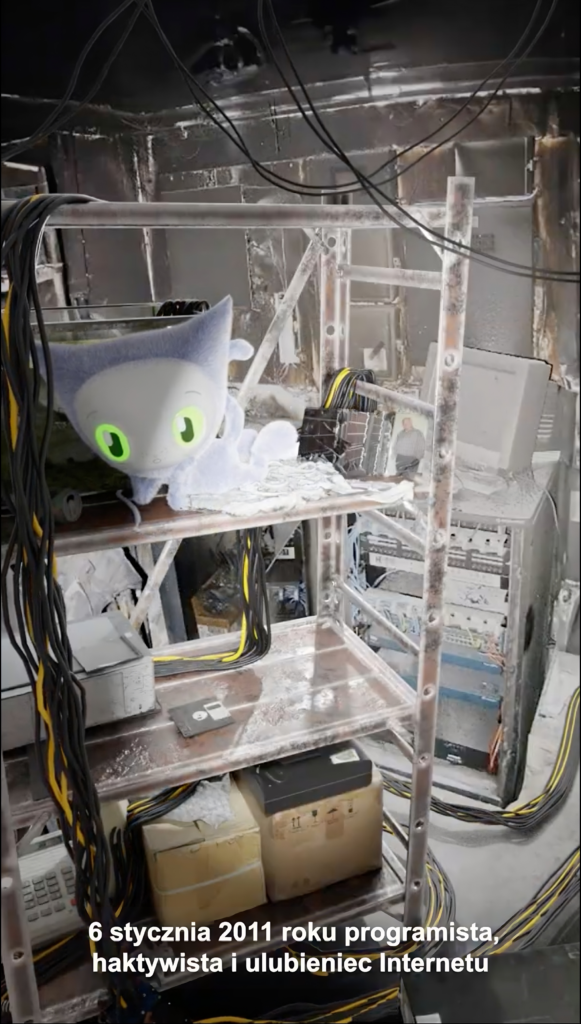
A mixture of dopamine and cortisol with a touch of endorphin is what we find in the three-channel video essay installation All Hardware Sucks, All Software Sucks by the duo Xtreme Girl and szkoda (Kasia Piątkowska). From the very start, I was watching in fascination, even though I knew exactly how every Internet utopia ends. My machine is in the middle of an interface fashioned after a yes/no flowchart. Adorable in the extreme, the avatar of Xtreme Girl, a corporate cat mascot, is speaking to me in a sweet voice in the language of contemporary critical theory. The speed and saturation of the narrative is stimulating my neurons. Everything in me is on the run. In the first part, The Labirynth, the Hacker, the Sprawl the Xtreme Girl avatar walks through server rooms and archives, telling the story of hacker utopias – the longing for endorphins flowing from the sense of a digital open-source community. In the second part, Was Sisyphus really a baby stuck on a conveyor belt, the cat avatar becomes a hustler. The artists argue that today’s equivalent of the mythological Sisyphus is the alpha male, the king of productivity, which he owes to his daily discipline of cold showers, exercise, self-improvement, work and diet. His day is regulated by protocols that include elements of dopamine kicks and serotonin boosts. The contemporary Sisyphus finally abandons the rock, challenging the dogma of work and the essence of grind culture. The final part of the work, Why game RPGs if you can play the system?, dedicated to the crypto environment, begins with a scene of Xtreme Girl staring at curved monitors that are characteristic of the crypto aesthetics. What molecules run the stock market and your crypto portfolio? They are driven by wild doses of dopamine, adrenaline and cortisol, which change in direct proportion to the profit and loss curve. The audio backdrop to this information-saturated yet endearing narrative is an unsettling sound design by szkoda (Kasia Piątkowska). Drawing on elements of pop culture and various genres of club music, it seems to be increasing the cortisol levels in my body by the moment. The vaguely dubstep density is punctuated by numerous glitches and tech bro announcements – like a vector of rumination, when you’re trying to focus but subconsciously feel that something is off. It’s the soundtrack blaring on boosted bass in the lambo the duo Xtreme Girl jump into in the final scene, escaping and leaving behind a landscape of neoliberal dystopia straight out of Silicon Valley. I smell burnt cables. Is it something here or in me that has overheated?
Doomer protocol of sadness
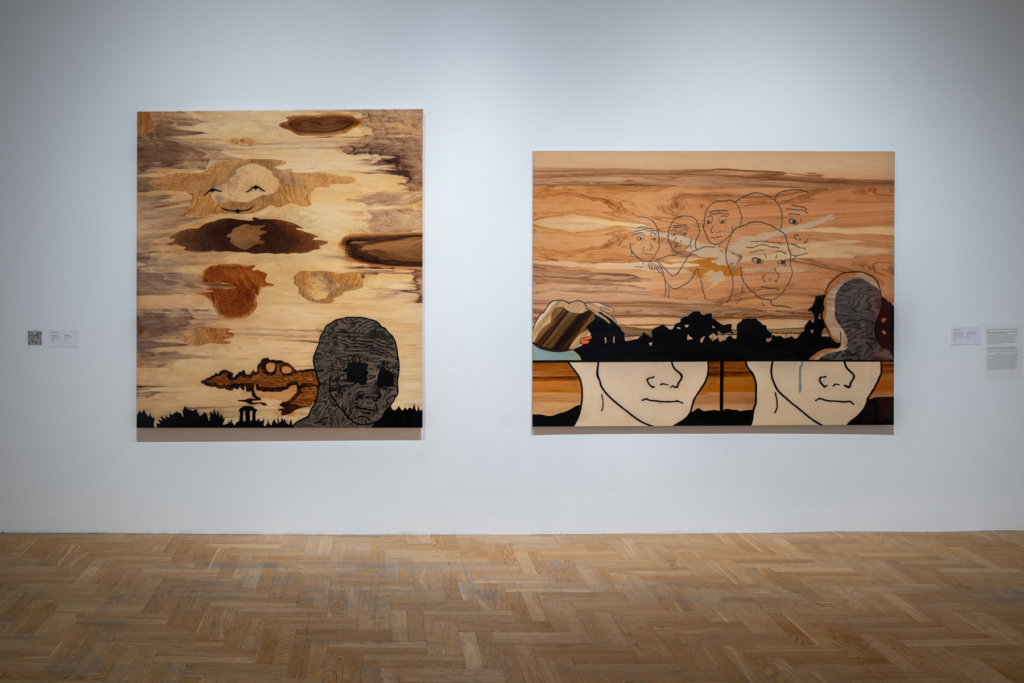
Karolina Jarzębak engages in doomer Internet archaeology, and her pareidolia of seeing faces in wooden knots is methodologically reminiscent of the dot-connecting of conspiracy theorists that the artist observes in her practice. Jarzębak’s smooth and shiny works give me an irresistible urge to scratch them. Although the symbols they depict belong to the Western cultural universe (Pepe the Frog associated with Donald Trump supporters[28], the everyman GI Joe), they are cast in wood by traditional inlay work, evoking Polish, conservative stuffiness: high-gloss wall units, doilies and Radio Maryja[29] playing in the background, the very thought of which will always give me a cortisol stiffness in every inch of my body. Even though Jarzębak’s creative process involves being chronically online in search of curiosities hidden in Internet forums and the dopamine Tik Tok content, the end effect is like the relief you feel after several hours of scrolling. The dopamine turns into cortisol, and even if there was a flash of endorphin-fuelled hope (like the smiling sun blinding GI Joe in ‘attached to nothing, connected to everything’), we are left alone, completely ♥D♥E♥A♥D♥ ♥I♥n♥s♥i♥d♥e♥.
[28] See https://knowyourmeme.com/memes/pepe-the-frog (accessed 17 April 2024).
[29] Radio Maryja – an ultra-conservative Catholic radio station in Poland that broadcasts religious and political content.
Hydro-pleasure protocol

The video installation and panorama presented by Justyna Górowska as part of the research-artist duo cyber_nymphs (Justyna Górowska and Ewelina Jarosz) have the character of an artefact promoting the hydrosexual movement. It calls for, among other things, seeking new relationships with non-human actors (or rather lovers of the hydrosexual narrative) and recognising water as the primordial matter and sexual energy as the primary force that drives the world. I am immersing myself in water and in coexistence with other beings. My machine is slowing down. In water my thoughts and I are becoming lighter. I am longing for blue, watery Tantra. I want my pelvis touch another pelvis and breathe together. The hydrosexual movement is made up of relationships – with people, technology, water and its ecosystem – based on a non-hierarchical approach, on giving and taking. It’s a fantasy about love – not the kind that burns out quickly, but a strong bond built on respect and tender touch that releases oxytocin. Activists in the hydrosexual movement are simultaneously immersed in water and technology, forming the techno-branch of the ecosexual movement. The Hydrosexual Manifesto[30] itself refers to other manifestos: the classic Cyberfeminist Manifesto[31], which advocates pleasure and technology as tools of emancipation[32], and the Ecosexual Manifesto, which recognises the earth as the subject of love. The video work, generated with the help of Midjourney[33] and featuring Agata Polak’s soundtrack, is presented in a cute, serotonin aesthetic designed to attract recipients. It’s a strategy for building ecological awareness based not on fear but on pleasure. The soothing voice of an AI narrator guides us through meditations, and the cyber_nymphs emerge from the water, attracting us with visual beauty – synchronising their breath with ours, taking our hand to draw us into the hydrosexual lake. The molecular aspect is also found in the water itself, which contains everything that humans produce and excrete – from pharmaceuticals to microplastics – affecting our hormonal economy[34].
[30] Hydrosex Manifesto, https://hydrosexmanifesto.cargo.site/info (accessed 17 April 2024).
[31] A Cyberfeminist Manifesto for the 21st Century, https://vnsmatrix.net/projects/the-cyberfeminist-manifesto-for-the-21st-century (accessed 17 April 2024).
[32] Ecosex Manifesto, http://sexecology.org/research-writing/ecosex-manifesto/ (accessed 17 April 2024).
[33] A generative artificial intelligence program and service created by San Francisco-based independent research lab Midjourney, Inc.
[34] See https://heathermdavis.com/wp-content/uploads/2014/08/Life-and-Death-in-the-Anthropocene.pdf (accessed 17 April 2024).
Fight protocol

Hormones are one of the most important elements of gender politics and the axis of common patriarchal narratives[35]. Testosterone means fight, oestrogen means care. So what is the hormonal landscape of a war in which women fight? Let’s ask the question with Donna Haraway and Rosi Braidotti: does the emancipation of women also mean their participation in killing? Echoing the philosophers, Agata Lankamer poses this unanswerable question and, at the same time, wonders whether it is even valid when war is an element of the contemporary landscape. The image of women with weapons is instrumentalised in many ways – a gun in delicate female hands is a sexual attribute used by nationalist and alt-right groups, as well as by national armies, as exemplified by American military psy-op campaigns[36], which use influencers, army e-girls[37], to shape their image. What would a weapon designed by women look like according to artificial intelligence? Answer: weapons in shades of pink and purple, with organic shapes. Lankamer’s warriors are cool cyborgs – the weapon is an integral part of their body. I don’t know who they’re aiming at, but they’re exceptionally focused. Their fighting does not look like a molecular storm, though it may be cortisol and dopamine that allow them to keep their emotions in check, make decisions, and be effective and resilient.
[35] Cordelia Fine, Testosteron Rex: Unmaking the Myths of Our Gendered Minds, London: Icon Books, 2017.
[36] Short for psychological operation.
[37] See https://www.dazeddigital.com/life-culture/article/57878/1/the-era-of-military-funded-e-girl-warfare-army-influencers-tiktok (accessed 17 April 2024).
My body is a machine that is poignant and bouncy at the same time
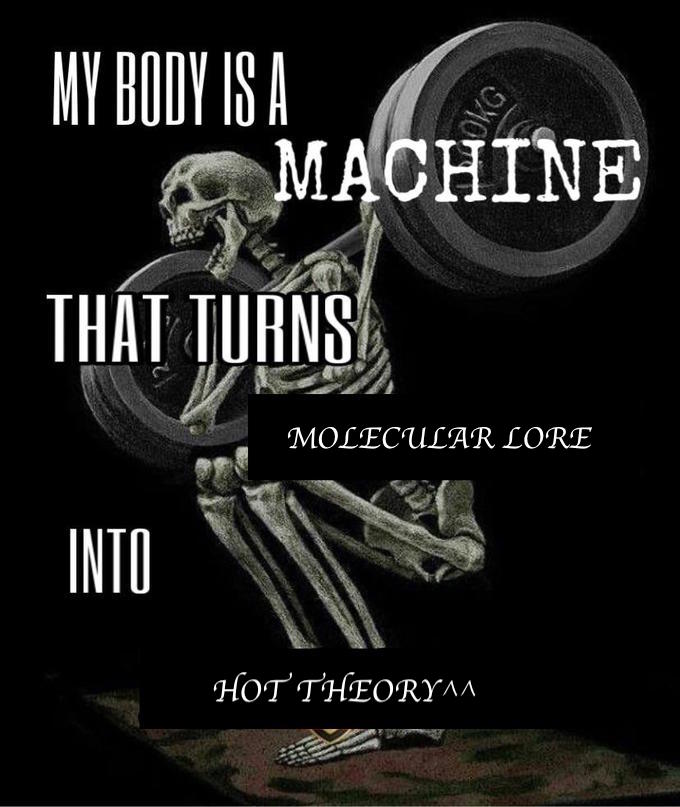
My body is a machine that turns molecular biohacks into soma-theory. For me, the experiment, both physical and mental, culminated in a week of extreme affects. Aware of my own game of subjectivity, I disrupted everything I could. My molecular protocol comprised: cold showers, masturbation, yoga nidra, watching Xtreme Girl’s pieces at different times of the day, hours of scrolling through Instagram, green smoothies, bingeing on TikTok, walks, hours spent with Agata Lankamer’s work, compulsive shopping on Vinted, hours of watching Justyna Górowska’s work, listening to binaural music that improves memory and concentration, sweets in huge quantities, dancing, jogging, watching porn, crying, sunbathing, searching for smileys in Karolina Jarzębak’s works, three days without leaving home, sun and social interaction, Lana Del Rey in large doses (especially listening to Ultraviolence), watching Sara Bezovšek’s videos for hours, deleting most of the apps on my phone, staring at the wall.
What is the pharmacopornographic method, both soft and hard? What does Testo Junkie have in common with artists who are extremely online? Like Preciado, their bodies become a field of experimentation – for something to explode in me, it has to explode in them first. They use stimuli – in the case of Preciado, a gel containing synthetic testosterone; in the case of the artists, content that releases a series of molecules in them – these stimuli become elements of a new protocol. They appropriate tools and use them contrary to their original purpose. In this shifting of vectors lies the subversive power of the pharmacopornographic method and its somato-theoretical potential. The artists propose new critical protocols: Sara Bezovšek’s End of the World Protocol, Xtreme Girl’s Speed Protocol, Karolina Jarzębak’s Protocol of Saddness, Justyna Górowska’s Hydro-Pleasure Protocol, Agata Lankamer’s Fight Protocol – these are machines for generating soma-theory that we can feel in the body. The authors of these works orchestrate my affect – they are anti-coaches, creating new critical dopamine pathways in me.
I swapped the equilibrium protocol for the deconstruction protocol, immersing myself in my own molecular imaginary, I felt everything I shouldn’t have and emerged reconstructing myself. My subject emerged strong and resilient, a its machine shining even brighter in the spring sun. If I am to optimise myself, I want it to serve only me and the aspects of life that matter to me. I fantasise about communes living according to rigorous motivational protocols aimed at reducing the effects of ecological disaster, about the hubs of anti-capitalist thought driven by ‘good’ dopamine. I can shift the vector of the protocol or reject it altogether. I will be staring at the wall with wild joy, doing everything that hormone coaches advise against, if only this slacker practice will help me to escape the moral fantasy of a good life. A life without sadness and worry, a life in which no one listens to Lana Del Rey because it affects well-being. I’m going to reject happiness protocols, reject productivity protocols. My body is a machine that craves full-spectrum affect, unrestrained, with all its jumps and instabilities. A machine that challenges the molecular equilibrium reproducing normative fantasies of happiness manifested by the clean girl. Let the girl be dirty.
To paraphrase Preciado, we can ‘manipulate molecules, not to be productive and happy, but rather to foil what society wants to make of us, so that we can write, create, fuck, feel a form of pleasure that is post-pornographic, add a molecular prostheses to our low-tech identity composed of dildos, memes, and moving images.’[38]
[38] Paraphrase of Preciado’s words from Testo Junkie: ‘I’m not taking testosterone to change myself into a man or as a physical strategy of transsexualism; I take it to foil what society wanted to make of me, so that I can write, fuck, feel a form of pleasure that is postpornographic, add a molecular prostheses to my low-tech transgender identity composed of dildos, texts, and moving images; I do it to avenge your death.’
Kat Zavada – hot academic chic🔥Digital art curator, artist, researcher and cyber-kmieciówa [digital serf]. Part of Nerdka collective. Fulbright Junior Research Award 2024–2025 Laureate. She is currently pursuing her PhD Technofeudalism – cartographies of digital monarchies at the Academy of Fine Arts in Kraków. She holds an MA in Curatorial Practice (Contemporary Art) from The Glasgow School of Art. Her research spans neoliberal tech utopias, South China Post, Reddit memes, and digital monarchies. She’s intrigued by topics related to technofeudalism and politics of software, data identity and data collection as an exercise of power as well as post-work imaginaries.

